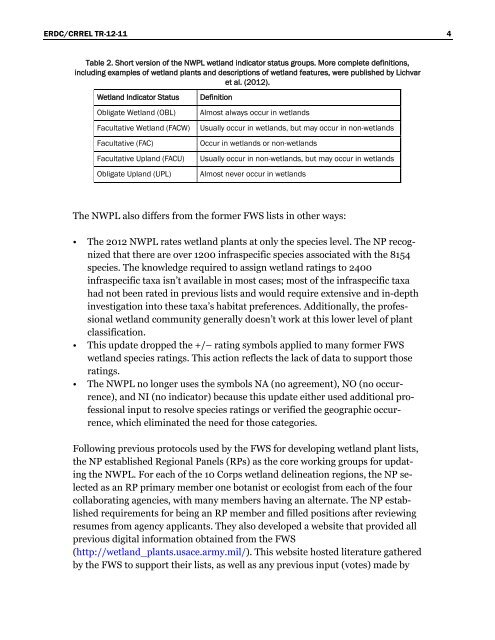The Nationwide Plant List, October 2012
The Nationwide Plant List, October 2012
The Nationwide Plant List, October 2012
You also want an ePaper? Increase the reach of your titles
YUMPU automatically turns print PDFs into web optimized ePapers that Google loves.
ERDC/CRREL TR-12-11 4<br />
Table 2. Short version of the NWPL wetland indicator status groups. More complete definitions,<br />
including examples of wetland plants and descriptions of wetland features, were published by Lichvar<br />
et al. (<strong>2012</strong>).<br />
Wetland Indicator Status Definition<br />
Obligate Wetland (OBL) Almost always occur in wetlands<br />
Facultative Wetland (FACW) Usually occur in wetlands, but may occur in non-wetlands<br />
Facultative (FAC) Occur in wetlands or non-wetlands<br />
Facultative Upland (FACU) Usually occur in non-wetlands, but may occur in wetlands<br />
Obligate Upland (UPL) Almost never occur in wetlands<br />
<strong>The</strong> NWPL also differs from the former FWS lists in other ways:<br />
• <strong>The</strong> <strong>2012</strong> NWPL rates wetland plants at only the species level. <strong>The</strong> NP recognized<br />
that there are over 1200 infraspecific species associated with the 8154<br />
species. <strong>The</strong> knowledge required to assign wetland ratings to 2400<br />
infraspecific taxa isn’t available in most cases; most of the infraspecific taxa<br />
had not been rated in previous lists and would require extensive and in-depth<br />
investigation into these taxa’s habitat preferences. Additionally, the professional<br />
wetland community generally doesn’t work at this lower level of plant<br />
classification.<br />
• This update dropped the +/– rating symbols applied to many former FWS<br />
wetland species ratings. This action reflects the lack of data to support those<br />
ratings.<br />
• <strong>The</strong> NWPL no longer uses the symbols NA (no agreement), NO (no occurrence),<br />
and NI (no indicator) because this update either used additional professional<br />
input to resolve species ratings or verified the geographic occurrence,<br />
which eliminated the need for those categories.<br />
Following previous protocols used by the FWS for developing wetland plant lists,<br />
the NP established Regional Panels (RPs) as the core working groups for updating<br />
the NWPL. For each of the 10 Corps wetland delineation regions, the NP selected<br />
as an RP primary member one botanist or ecologist from each of the four<br />
collaborating agencies, with many members having an alternate. <strong>The</strong> NP established<br />
requirements for being an RP member and filled positions after reviewing<br />
resumes from agency applicants. <strong>The</strong>y also developed a website that provided all<br />
previous digital information obtained from the FWS<br />
(http://wetland_plants.usace.army.mil/). This website hosted literature gathered<br />
by the FWS to support their lists, as well as any previous input (votes) made by


